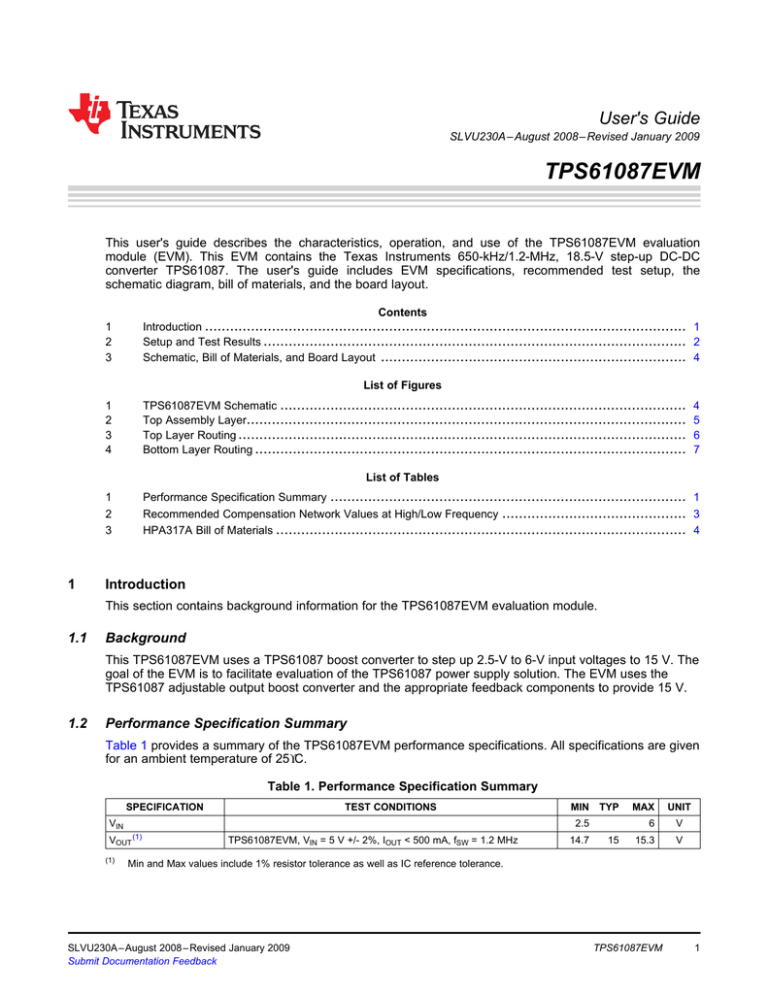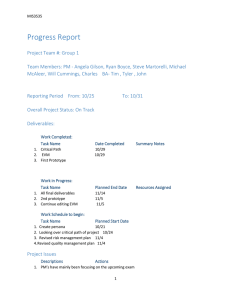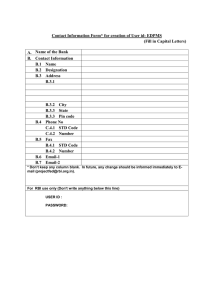TPS61087EVM (Rev. A
advertisement

User's Guide SLVU230A – August 2008 – Revised January 2009 TPS61087EVM This user's guide describes the characteristics, operation, and use of the TPS61087EVM evaluation module (EVM). This EVM contains the Texas Instruments 650-kHz/1.2-MHz, 18.5-V step-up DC-DC converter TPS61087. The user's guide includes EVM specifications, recommended test setup, the schematic diagram, bill of materials, and the board layout. Contents Introduction ................................................................................................................... 1 Setup and Test Results ..................................................................................................... 2 Schematic, Bill of Materials, and Board Layout ......................................................................... 4 1 2 3 List of Figures TPS61087EVM Schematic ................................................................................................. Top Assembly Layer......................................................................................................... Top Layer Routing ........................................................................................................... Bottom Layer Routing ....................................................................................................... 1 2 3 4 4 5 6 7 List of Tables Performance Specification Summary ..................................................................................... 1 Recommended Compensation Network Values at High/Low Frequency ............................................ 3 HPA317A Bill of Materials .................................................................................................. 4 1 2 3 1 Introduction This section contains background information for the TPS61087EVM evaluation module. 1.1 Background This TPS61087EVM uses a TPS61087 boost converter to step up 2.5-V to 6-V input voltages to 15 V. The goal of the EVM is to facilitate evaluation of the TPS61087 power supply solution. The EVM uses the TPS61087 adjustable output boost converter and the appropriate feedback components to provide 15 V. 1.2 Performance Specification Summary Table 1 provides a summary of the TPS61087EVM performance specifications. All specifications are given for an ambient temperature of 25°C. Table 1. Performance Specification Summary SPECIFICATION TEST CONDITIONS VIN TYP 2.5 VOUT (1) MIN (1) TPS61087EVM, VIN = 5 V +/- 2%, IOUT < 500 mA, fSW = 1.2 MHz 14.7 15 MAX UNIT 6 V 15.3 V Min and Max values include 1% resistor tolerance as well as IC reference tolerance. SLVU230A – August 2008 – Revised January 2009 Submit Documentation Feedback TPS61087EVM 1 Setup and Test Results 2 www.ti.com Setup and Test Results This section describes how to properly connect, set up, and use the TPS61087EVM. 2.1 Input/Output Connections The connection points are described in the following paragraphs. 2.1.1 J1-VIN and GND This header is the positive (pins 1 to 3) and return (pins 4 to 6) connections to the input power supply. The leads to the input supply should be twisted and kept as short as possible. The input voltage has to be between 2.5 V and 6 V. 2.1.2 J4-VOUT and GND This header is the positive output (pins 1 to 3) and the return connection (pins 4 to 6) for the device. 2.1.3 J2-EN Placing a jumper across pins 1 and 2 ties the EN pin to VIN, thereby enabling the device. Placing a jumper across pins 2 and 3 ties the EN pin to GND, which disables the device. 2.1.4 JP3-FREQ The middle pin of this jumper connects to the FREQ pin of the IC. Placing this jumper across pins 1 and 2 ties the FREQ pin to VIN, thereby implementing a 1.2-MHz switching frequency. Placing this jumper across pins 2 and 3 ties the FREQ pin to ground, thereby implementing a 650-kHz switching frequency. 2.2 EVM Operation The user must connect an input power supply set between 2.5 V and 6 V at header J1 in order for the EVM to operate. The absolute maximum input voltage is 7 V. The user can connect a load resistance at J4. Connect a jumper between pins 1 and 2 of J2 to enable the device. 2.3 Compensation (R1, C6) The regulator loop can be compensated by adjusting the external components connected to the COMP pin. The COMP pin is the output of the internal transconductance error amplifier. Standard values of RCOMP = 16 kΩ and CCOMP = 2.7 nF will work for the majority of the applications. Refer to Table 2 for dedicated compensation networks giving an improved load transient response. The following equations can be used to calculate RCOMP and CCOMP: R COMP = 2 110 × V IN × V S × Cout L × Iout_max TPS61087EVM C COMP = V S × Cout 7.5 × Iout_max × R COMP (1) SLVU230A – August 2008 – Revised January 2009 Submit Documentation Feedback Setup and Test Results www.ti.com Table 2. Recommended Compensation Network Values at High/Low Frequency FREQUENCY L (µH) VS (V) 15 High (1.2 MHz) 3.3 12 9 15 Low (650 kHz) 6.8 12 9 VIN ± 20% (V) RCOMP (kΩ) CCOMP 820 pF 5 100 3.3 91 1.2 nF 5 68 820 pF 3.3 68 1.2 nF 5 39 820 pF 3.3 39 1.2 nF 5 51 1.5 nF 3.3 47 2.7 nF 5 33 1.5 nF 3.3 33 2.7 nF 5 18 1.5 nF 3.3 18 2.7 nF Table 2 gives conservatives Rcomp and Comp values for certain inductors, input and output voltages providing a very stable system. For a faster response time, a higher Rcomp value can be used to enlarge the bandwidth, as well as a slightly lower value of Ccomp to keep enough phase margin. These adjustments should be performed in parallel with the load transient response monitoring of TPS61087. SLVU230A – August 2008 – Revised January 2009 Submit Documentation Feedback TPS61087EVM 3 Schematic, Bill of Materials, and Board Layout 3 www.ti.com Schematic, Bill of Materials, and Board Layout This section provides the TPS61087EVM bill of materials and schematics. Compensation is optimized for stability for different LC output filters. To optimize for fast transient response, see Section 2.3. 3.1 Schematic Figure 1. TPS61087EVM Schematic 3.2 Bill of Materials Table 3. HPA317A Bill of Materials RefDes Value Description Size Part Number MFR C1, C2 10 µF Capacitor, Ceramic, 10V, X7R or X5R, 10% 0805 GRM21BR71A106KE51 or LMK212BJ106KG-T Murata or Taiyo Yuden C3 1 µF Capacitor, Ceramic, 16V, X7R or X5R, 10% 0805 GRM21BR71C105KA01 or EMK212B7105KG-T Murata or Taiyo Yuden C4 33 nF Capacitor, Ceramic, 16V, X7R, 10% 0805 Std Std C5 Open Capacitor, Ceramic, 16V, X7R 0805 Std Std C6 2.7 nF Capacitor, Ceramic, 16V, X7R, 10% 0805 Std Std C7, C8, C9, C10 10 µF Capacitor, Ceramic, 25V, X7R or X5R, 10% 1206 GRM31CR61E106KA12 or TMK316BJ106KL-T Murata or Taiyo Yuden D1 SL22 Diode, Schottky Rectifier, 2A, 20 V DO-214AA SL22 Vishay J1, J4 Header, Male 6-pin, 100mil spacing 0.100 inch x 6 Std Std J2, J3 Header, Male 3-pin, 100mil spacing 0.100 inch x 3 Std Std Inductor, SMT, 3.42A, 24 milliohm 0.288 x 0.288 inch 7447789003 Wurth Elektronik L1 R1 16k Resistor, Chip, 1/10W, 1% 0805 Std Std R2 200k Resistor, Chip, 1/10W, 1% 0805 Std Std R3 18k Resistor, Chip, 1/10W, 1% 0805 Std Std R4 0 Resistor, Chip, 1/10W, 5% 0805 Std Std SON-10 TPS6108DSC TI U1 4 3.3 µH TPS61087DSC IC, 600kHz/1.2MHz Step-Up DC-DC Converter — PCB 2.4 In x 1.65 In x 0.062 In HPA317 Any — Shunt, 100-mil, Black 0.100 929950-00 3M TPS61087EVM SLVU230A – August 2008 – Revised January 2009 Submit Documentation Feedback www.ti.com 3.3 Schematic, Bill of Materials, and Board Layout Board Layout This section provides the TPS61087EVM board layout and illustrations. 3.3.1 Layout Board layout is critical for all switch-mode power supplies. Figure 2, Figure 3, and Figure 4 show the board layout for the HPA317 PCB. The switching nodes with high-frequency noise are isolated from the noise-sensitive feedback circuitry, and careful attention has been given to the routing of high-frequency current loops. See the data sheet for further layout guidelines. Figure 2. Top Assembly Layer SLVU230A – August 2008 – Revised January 2009 Submit Documentation Feedback TPS61087EVM 5 Schematic, Bill of Materials, and Board Layout www.ti.com Figure 3. Top Layer Routing 6 TPS61087EVM SLVU230A – August 2008 – Revised January 2009 Submit Documentation Feedback Schematic, Bill of Materials, and Board Layout www.ti.com Figure 4. Bottom Layer Routing SLVU230A – August 2008 – Revised January 2009 Submit Documentation Feedback TPS61087EVM 7 EVALUATION BOARD/KIT IMPORTANT NOTICE Texas Instruments (TI) provides the enclosed product(s) under the following conditions: This evaluation board/kit is intended for use for ENGINEERING DEVELOPMENT, DEMONSTRATION, OR EVALUATION PURPOSES ONLY and is not considered by TI to be a finished end-product fit for general consumer use. Persons handling the product(s) must have electronics training and observe good engineering practice standards. As such, the goods being provided are not intended to be complete in terms of required design-, marketing-, and/or manufacturing-related protective considerations, including product safety and environmental measures typically found in end products that incorporate such semiconductor components or circuit boards. This evaluation board/kit does not fall within the scope of the European Union directives regarding electromagnetic compatibility, restricted substances (RoHS), recycling (WEEE), FCC, CE or UL, and therefore may not meet the technical requirements of these directives or other related directives. Should this evaluation board/kit not meet the specifications indicated in the User’s Guide, the board/kit may be returned within 30 days from the date of delivery for a full refund. THE FOREGOING WARRANTY IS THE EXCLUSIVE WARRANTY MADE BY SELLER TO BUYER AND IS IN LIEU OF ALL OTHER WARRANTIES, EXPRESSED, IMPLIED, OR STATUTORY, INCLUDING ANY WARRANTY OF MERCHANTABILITY OR FITNESS FOR ANY PARTICULAR PURPOSE. The user assumes all responsibility and liability for proper and safe handling of the goods. Further, the user indemnifies TI from all claims arising from the handling or use of the goods. Due to the open construction of the product, it is the user’s responsibility to take any and all appropriate precautions with regard to electrostatic discharge. EXCEPT TO THE EXTENT OF THE INDEMNITY SET FORTH ABOVE, NEITHER PARTY SHALL BE LIABLE TO THE OTHER FOR ANY INDIRECT, SPECIAL, INCIDENTAL, OR CONSEQUENTIAL DAMAGES. TI currently deals with a variety of customers for products, and therefore our arrangement with the user is not exclusive. TI assumes no liability for applications assistance, customer product design, software performance, or infringement of patents or services described herein. Please read the User’s Guide and, specifically, the Warnings and Restrictions notice in the User’s Guide prior to handling the product. This notice contains important safety information about temperatures and voltages. For additional information on TI’s environmental and/or safety programs, please contact the TI application engineer or visit www.ti.com/esh. No license is granted under any patent right or other intellectual property right of TI covering or relating to any machine, process, or combination in which such TI products or services might be or are used. FCC Warning This evaluation board/kit is intended for use for ENGINEERING DEVELOPMENT, DEMONSTRATION, OR EVALUATION PURPOSES ONLY and is not considered by TI to be a finished end-product fit for general consumer use. It generates, uses, and can radiate radio frequency energy and has not been tested for compliance with the limits of computing devices pursuant to part 15 of FCC rules, which are designed to provide reasonable protection against radio frequency interference. Operation of this equipment in other environments may cause interference with radio communications, in which case the user at his own expense will be required to take whatever measures may be required to correct this interference. EVM WARNINGS AND RESTRICTIONS It is important to operate this EVM within the input voltage range of 2.5 V to 6 V and the output voltage range of up to 18.5 V, but 15 V as configured. Exceeding the specified input range may cause unexpected operation and/or irreversible damage to the EVM. If there are questions concerning the input range, please contact a TI field representative prior to connecting the input power. Applying loads outside of the specified output range may result in unintended operation and/or possible permanent damage to the EVM. Please consult the EVM User's Guide prior to connecting any load to the EVM output. If there is uncertainty as to the load specification, please contact a TI field representative. During normal operation, some circuit components may have case temperatures greater than 125° C. The EVM is designed to operate properly with certain components above 85° C as long as the input and output ranges are maintained. These components include but are not limited to linear regulators, switching transistors, pass transistors, and current sense resistors. These types of devices can be identified using the EVM schematic located in the EVM User's Guide. When placing measurement probes near these devices during operation, please be aware that these devices may be very warm to the touch. Mailing Address: Texas Instruments, Post Office Box 655303, Dallas, Texas 75265 Copyright © 2008-2009, Texas Instruments Incorporated IMPORTANT NOTICE Texas Instruments Incorporated and its subsidiaries (TI) reserve the right to make corrections, modifications, enhancements, improvements, and other changes to its products and services at any time and to discontinue any product or service without notice. Customers should obtain the latest relevant information before placing orders and should verify that such information is current and complete. All products are sold subject to TI’s terms and conditions of sale supplied at the time of order acknowledgment. TI warrants performance of its hardware products to the specifications applicable at the time of sale in accordance with TI’s standard warranty. Testing and other quality control techniques are used to the extent TI deems necessary to support this warranty. Except where mandated by government requirements, testing of all parameters of each product is not necessarily performed. TI assumes no liability for applications assistance or customer product design. Customers are responsible for their products and applications using TI components. To minimize the risks associated with customer products and applications, customers should provide adequate design and operating safeguards. TI does not warrant or represent that any license, either express or implied, is granted under any TI patent right, copyright, mask work right, or other TI intellectual property right relating to any combination, machine, or process in which TI products or services are used. Information published by TI regarding third-party products or services does not constitute a license from TI to use such products or services or a warranty or endorsement thereof. Use of such information may require a license from a third party under the patents or other intellectual property of the third party, or a license from TI under the patents or other intellectual property of TI. Reproduction of TI information in TI data books or data sheets is permissible only if reproduction is without alteration and is accompanied by all associated warranties, conditions, limitations, and notices. Reproduction of this information with alteration is an unfair and deceptive business practice. TI is not responsible or liable for such altered documentation. Information of third parties may be subject to additional restrictions. Resale of TI products or services with statements different from or beyond the parameters stated by TI for that product or service voids all express and any implied warranties for the associated TI product or service and is an unfair and deceptive business practice. TI is not responsible or liable for any such statements. TI products are not authorized for use in safety-critical applications (such as life support) where a failure of the TI product would reasonably be expected to cause severe personal injury or death, unless officers of the parties have executed an agreement specifically governing such use. Buyers represent that they have all necessary expertise in the safety and regulatory ramifications of their applications, and acknowledge and agree that they are solely responsible for all legal, regulatory and safety-related requirements concerning their products and any use of TI products in such safety-critical applications, notwithstanding any applications-related information or support that may be provided by TI. Further, Buyers must fully indemnify TI and its representatives against any damages arising out of the use of TI products in such safety-critical applications. TI products are neither designed nor intended for use in military/aerospace applications or environments unless the TI products are specifically designated by TI as military-grade or "enhanced plastic." Only products designated by TI as military-grade meet military specifications. Buyers acknowledge and agree that any such use of TI products which TI has not designated as military-grade is solely at the Buyer's risk, and that they are solely responsible for compliance with all legal and regulatory requirements in connection with such use. TI products are neither designed nor intended for use in automotive applications or environments unless the specific TI products are designated by TI as compliant with ISO/TS 16949 requirements. Buyers acknowledge and agree that, if they use any non-designated products in automotive applications, TI will not be responsible for any failure to meet such requirements. Following are URLs where you can obtain information on other Texas Instruments products and application solutions: Products Amplifiers Data Converters DLP® Products DSP Clocks and Timers Interface Logic Power Mgmt Microcontrollers RFID RF/IF and ZigBee® Solutions amplifier.ti.com dataconverter.ti.com www.dlp.com dsp.ti.com www.ti.com/clocks interface.ti.com logic.ti.com power.ti.com microcontroller.ti.com www.ti-rfid.com www.ti.com/lprf Applications Audio Automotive Broadband Digital Control Medical Military Optical Networking Security Telephony Video & Imaging Wireless www.ti.com/audio www.ti.com/automotive www.ti.com/broadband www.ti.com/digitalcontrol www.ti.com/medical www.ti.com/military www.ti.com/opticalnetwork www.ti.com/security www.ti.com/telephony www.ti.com/video www.ti.com/wireless Mailing Address: Texas Instruments, Post Office Box 655303, Dallas, Texas 75265 Copyright © 2009, Texas Instruments Incorporated


